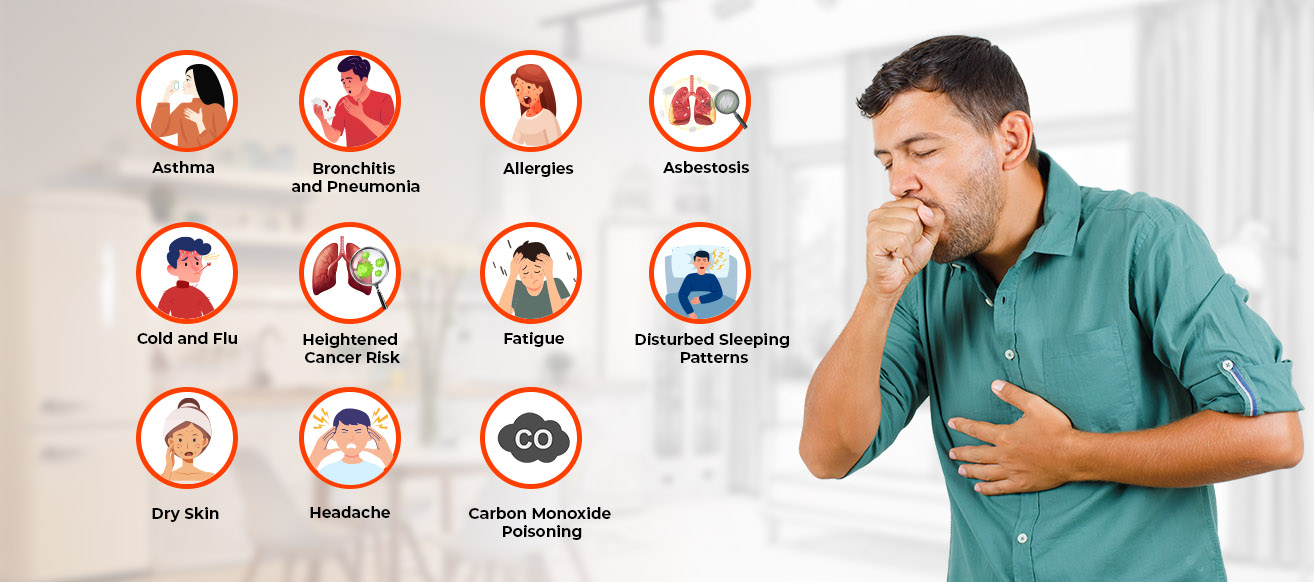Indoor air quality is a crucial concern that is often overlooked. As we breathe, we are surrounded by hidden dangers in homes, offices, and closed spaces. Poor indoor air affects our health, from fleeting discomfort to long-term issues. Common indoor items emit substances that linger and affect indoor air quality. Acknowledging these concealed threats empowers us to safeguard ourselves and our loved ones, making informed choices for healthier living. Air pollution is caused by particles and gases that harm when inhaled, and air quality is the measure of air cleanliness. However, we must equip ourselves with the knowledge of indoor air quality to foster positive change.
What are the dangers of poor indoor air quality?
Poor indoor air quality can have many negative health consequences. However, specific vulnerable groups such as children, the elderly, and individuals with pre-existing health conditions are especially prone to the impacts of compromised air quality. Following are some of the major health hazards due to poor indoor air quality:
- Asthma: It is a chronic respiratory ailment characterized by inflammation in the airways, giving rise to breathing difficulties like coughing, wheezing, and breathlessness. In serious cases, it can even have life-threatening risks. Moreover, long-term exposure to harmful pollutants can trigger more grave health issues like lung cancer, heart disease, and permanent respiratory complications.
- Bronchitis and Pneumonia: Indoor smoking of tobacco products releases harmful substances into the air, such as nicotine, tar, carbon monoxide, and various cancer-causing agents. These toxic elements can persist in the air even after smoking ends, subjecting occupants to their adverse consequences. This smoke can cause asthma, bronchitis, and pneumonia. Furthermore, children become susceptible to ear infections, and their lung development may be stunted, possibly resulting in chronic respiratory challenges during adulthood.
- Headache: Household items like paints, cleaning products, adhesives, and furniture emit volatile organic compounds (VOCs) when used indoors without adequate ventilation. These can remain in the air, leading to headaches and potential long-term health concerns.
- Carbon Monoxide Poisoning: Carbon monoxide (CO) constitutes a dangerous air pollutant. When stoves, fireplaces, and heating systems undergo incomplete fuel combustion, they release this hazardous gas. In spaces without proper ventilation, CO can amass, posing health and safety risks by poisoning.
- Asbestosis: Asbestos poses a significant risk due to its tendency to release minuscule fibers into the air when disturbed. These fibers can linger for extended periods, becoming more likely to be inhaled. Upon entry into the airways, they can embed in the lungs, inducing inflammation and eventual scarring. Extended exposure to asbestos furthers the health risks, like mesothelioma, lung cancer, and asbestosis.
- Disturbed Sleeping Patterns: Inadequate air quality has the potential to disturb sleep cycles, resulting in tiredness, reduced cognitive performance, and an overall deterioration of one’s state of well-being.
- Allergies: Indoor air pollution can set off allergic reactions. Many people struggle with respiratory allergies. When exposed to specific substances, they might encounter allergy attacks marked by symptoms such as sneezing, irritated and red eyes, nasal congestion, and headaches.
- Cold and Flu: Whether or not you suffer from respiratory allergies, avoiding indoor air pollution is crucial to prevent cold and flu infections. While infections can happen anywhere, the chances rise in spaces with poor air quality, as higher pollution levels foster germ concentration and potential infection.
- Heightened Cancer Risk: Specific airborne pollutants possess carcinogenic properties, implying their capability to initiate or contribute to the development of cancer.
- Fatigue: Studies have highlighted a connection between indoor air pollution and fatigue. Prolonged exposure to indoor air pollution can lead to persistent low energy levels. Numerous airborne pollutants can disrupt your body’s metabolic functions, potentially contributing to feelings of tiredness.
- Dry Skin: Indoor air pollution’s reach extends to cause dry skin, a surprising effect. Healthy skin thrives on moisture, which the air usually provides. Yet, heightened indoor pollution deposits particles like dust onto the skin, reducing moisture. Over time, this buildup can lead to noticeable skin dryness.
Conclusion
Indoor air quality can be enhanced through steps like acquiring a high-efficiency air filter, HVAC upkeep, and expert services. Professional testing with indoor air quality monitoring devices affects indoor air quality positively. Remember, boosting air quality proactively betters health and embraces a healthier lifestyle.
Did you know all these health hazards of poor indoor air quality? Was this blog helpful? For more information visit the website, https://handholdersglobal.com/insights.
We are just one call away. Call us at +91 8926060752 for any query.









